Many bloggers work hard on their posts, only to see poor search engine rankings and low blog traffic. It is frustrating when content does not appear in search results or doesn’t reach its target audience.
This issue often arises because posts do not use proper on-page optimization and lack effective SEO tools.
In this guide, we explain 5 essential content optimization tools for bloggers. You will learn how each tool improves search engine optimization, boosts organic traffic, raises click-through rates, and produces better posts.
The guide details which tool may enhance your search engine ranking today. The information supports informed decisions about your content strategy.
Why Optimizing Content is Crucial for Bloggers in 2025?

Google plans to introduce AI-organized search results with particular attention to a few industries in 2025. This change requires bloggers to conduct detailed keyword research, incorporate long-tail keywords, enhance meta tags, and boost technical SEO to appear higher on search engine results pages.
As search algorithms change frequently, original content becomes increasingly important. Audiences appreciate fresh writing that avoids keyword stuffing and generic expressions.
Unique content protects you from plagiarism penalties while building trust with your readers. Clear layouts, a sound internal linking strategy, effective anchor text, and well-crafted meta descriptions – all contribute to improved organic traffic and higher click-through rates.
SEO-optimized content works best when it matches what readers want right now. Clear and easy-to-read text helps hold the audience’s interest. This increases dwell time and sends positive signals to search engines. Routine site auditing ensures that each post meets high standards for quality content in the competitive space of 2025.
5 Most Essential Content Optimization Tools for Bloggers

Choosing the proper content optimization tools can help your blog posts stand out on search engines. These resources enhance keyword research, serve on-page SEO needs, and increase visual appeal.
1. Plagiarism Checker
Plagiarized content frequently triggers search engine penalties and harms site credibility. A plagiarism checker uses artificial intelligence to scan posts against various online sources, making it easier to spot duplicate text that could lower your search engine rankings or negatively affect on-page optimization.
Bloggers who use such a tool can quickly detect copied material and obtain links to original sources for proper citation.
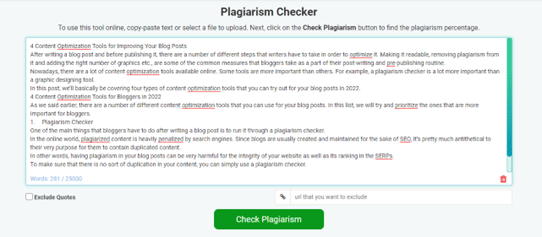
Plagiarism checkers help maintain compliance with best practices in technical SEO and shield you from copyright issues. Each checker shows matching passages and URLs, which support proper attribution in meta descriptions or outbound links.
Integrating a plagiarism checker into your workflow helps produce unique, high-quality content. This approach improves content marketing outcomes and preserves a strong search engine ranking for targeted long-tail keywords.
Benefits of using a plagiarism checker:
- A plagiarism checker identifies copied sections of your article, helping you avoid duplicate content penalties from search engines like Google.
- It provides direct URLs or sources to cite original authors and maintain proper metadata in your blogs.
- These tools assess if duplication levels fall within acceptable limits, allowing you to publish high-quality content confidently.
- They support technical SEO by flagging passages that could harm your blog’s organic traffic or search engine ranking.
- Fast checks save time on editing, allowing bloggers to focus on other vital tasks.
Recommended tools: Copyscape | Prepostseo | Quetext | Originality Plagiarism Checker.
2. Paraphrasing Tool
A paraphrasing tool helps rewrite content to improve clarity and remove repetitive phrases. Bloggers use these tools for rapid on-page optimization and overall SEO content optimization.
These platforms alter sentence structure swiftly while preserving the original meaning. Writers use them to eliminate plagiarism without sacrificing quality, which helps posts achieve better search engine ranking.
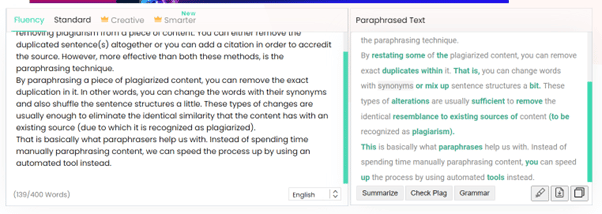
These tools boost keyword research by permitting the natural inclusion of long-tail keywords and semantic keywords in your posts. A paraphrasing tool saves time for bloggers who seek high-quality content with an easy reading level.
Paraphrasing software can make each post unique while keeping your main ideas clear.
Benefits of using a paraphrasing tool:
- Improves the uniqueness of each blog post, helping to boost search engine ranking and raise CTR.
- Accelerates content creation by automatically rewriting text faster than manual editing methods.
- Reduces redundancy in writing, making posts sound more professional and clear for readers.
- Simplifies complex sentences to target a wider audience and boost dwell time through better engagement.
- Supports proper keyword density and the strategic use of semantic keywords for higher organic traffic and improved search engine ranking.
Recommended tools: Paraphraser | QuillBot | Paraphrase Online.
3. Summarizing Tool
Summarizing tools help condense extensive content into clear and accurate abstracts or excerpts. They enhance readability by turning detailed posts into concise summaries that are easy to scan.
Bloggers use these tools to emphasize key ideas while maintaining an engaging tone. This method saves editing time and boosts dwell time by making articles easier to read.
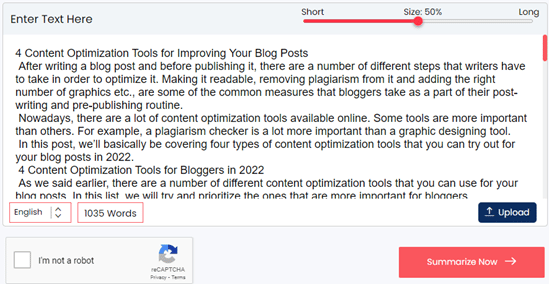
A summarizing tool aids in creating meta descriptions, improving on-page SEO, and supporting internal linking strategies. Readers remain engaged when content is straightforward to skim.
For keyword research, these solutions extract semantic keywords from large text blocks, ensuring that long-tail keywords are prominent in your strategy. Google Analytics may reveal improved CTR when short summaries appear at the top of posts or beneath headlines.
Concise snippets provide search engine crawlers with clearer signals about core topics, contributing to improved search engine rankings over time.
Benefits of using a summarizing tool:
- Generates concise versions of lengthy posts in seconds, which improves reader focus and engagement with high-quality content.
- Allows adjustment of summary length for various needs, supporting SEO content optimization and on-page SEO strategies.
- Enhances clarity by eliminating extra words, helping to boost your post’s readability score and dwell time.
- Makes research easier by extracting key facts, long-tail keywords, and semantic keywords from competitor analysis or Google Analytics reports.
- Improves CTR as readers view a quick snapshot in meta descriptions or schema markup on the SERP.
- Boosts efficiency for web design teams requiring summaries for image captions or quick content briefs using SEO plugins.
Recommended tools: Summarizing Tool | SummarizeBot | SMMRY.
4. Readability Checker
Readability checkers identify sentences and words that hinder easy reading and highlight issues such as excessive adverbs or passive voice.
These tools improve your readability score and help create high-quality content that is easy for users to understand.
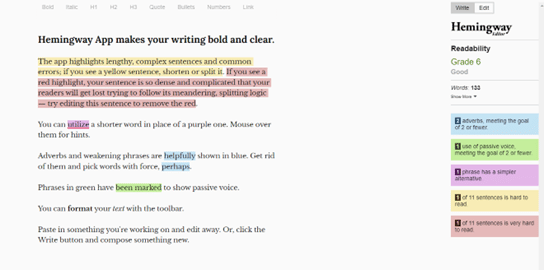
Clear structure and active language keep readers on the page longer. Improved reading ease can boost dwell time, CTR, and organic traffic in search engine rankings.
Bloggers use readability checkers to adjust keyword density and optimize the use of semantic keywords. A better Flesch-Kincaid score contributes to stronger meta descriptions and enhanced performance in Google Search Console analytics.
Benefits of using a readability checker:
- Boosts SEO by increasing your content’s readability score, aiding in higher ranking on SERPs.
- Identifies hard-to-read sentences faster than manual editing, saving time and effort.
- Supports technical SEO and on-page optimization by ensuring content is clear for both users and search algorithms.
- Flag overuse of jargon or excessive keyword density that could affect search engine ranking.
- Recommends organizing information with bullet points or shorter paragraphs for easier scanning.
Recommended tools: Hemingway App | Grammarly | ProWritingAid.
5. Graphic Design Tool
Graphic design tools help create custom graphics that make blog posts stand out. They enable the replacement of standard stock images with unique designs that support your content strategy.
Original visuals can boost your blog’s CTR and dwell time. Readers spend more time on pages rich with visuals, which aids SEO content optimization and enhances search engine rankings.
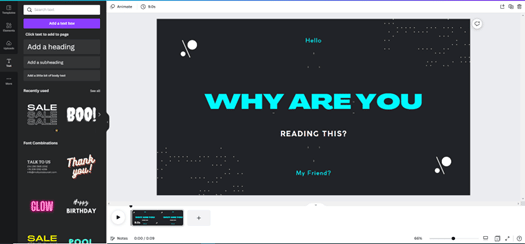
High-quality graphics support on-page SEO by highlighting long-tail keywords within infographics or banners. Modern tools enable users to drag and drop design elements easily, even without prior graphic skills.
Some tools also convert data into attractive charts with ease. Compressing images before uploading ensures fast page loading times, which is favored by Google Pagespeed scores.
Bloggers who use these tools achieve better engagement metrics and higher organic traffic from image-optimized posts.
Benefits of using a graphic design tool:
- Custom graphics improve your post’s visual appeal, capturing the reader’s attention immediately. This boosts reader engagement and dwell time, which supports higher search engine rankings.
- Professional designs build trust and make content appear more credible to readers and search engines.
- Templates from these tools speed up the design process, saving time for other vital tasks. Beginners can create quality visuals using simple drag-and-drop editors and prebuilt layouts, making content optimization more accessible.
- Image compression features help maintain fast page speed, vital for high search engine ranking and lower bounce rates.
- Branded images reinforce your identity across posts, encouraging repeat visits as users recognize your style.
Recommended tools: Canva | Piktochart | BeFunky.
Conclusion

Content optimization tools play a vital role in producing high-quality blog posts and boosting search engine rankings.
Plagiarism checkers shield your work and help you avoid penalties from Google’s algorithm. Paraphrasing, summarizing, and readability tools clarify content and preserve its uniqueness while saving time. Graphic design platforms add a visual edge that increases user engagement and organic traffic.






